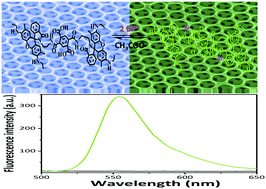当前位置:
X-MOL 学术
›
J. Mater. Chem. C
›
论文详情
Our official English website, www.x-mol.net, welcomes your feedback! (Note: you will need to create a separate account there.)
Fluorescence-enhancing film sensor for highly effective detection of Bi3+ ions based on SiO2 inverse opal photonic crystals†
Journal of Materials Chemistry C ( IF 6.4 ) Pub Date : 2018-06-15 00:00:00 , DOI: 10.1039/c8tc01461b Yuqi Zhang 1, 2, 3, 4, 5 , Qiaorong Li 1, 2, 3, 4, 5 , Pu Guo 1, 2, 3, 4, 5 , Ensheng Zhang 1, 2, 3, 4, 5 , Kai Wu 1, 2, 3, 4, 5 , Yao Liu 1, 2, 3, 4, 5 , Haiming Lv 1, 2, 3, 4, 5 , Xueyan Hou 1, 2, 3, 4, 5 , Ji-Jiang Wang 1, 2, 3, 4, 5
Journal of Materials Chemistry C ( IF 6.4 ) Pub Date : 2018-06-15 00:00:00 , DOI: 10.1039/c8tc01461b Yuqi Zhang 1, 2, 3, 4, 5 , Qiaorong Li 1, 2, 3, 4, 5 , Pu Guo 1, 2, 3, 4, 5 , Ensheng Zhang 1, 2, 3, 4, 5 , Kai Wu 1, 2, 3, 4, 5 , Yao Liu 1, 2, 3, 4, 5 , Haiming Lv 1, 2, 3, 4, 5 , Xueyan Hou 1, 2, 3, 4, 5 , Ji-Jiang Wang 1, 2, 3, 4, 5
Affiliation

|
Herein, we report Rhodamine 6G derivative-infiltrated SiO2 inverse opal photonic crystals (IOPC) as a fluorescence-enhancing film sensor for the detection of Bi3+ ions. In the presence of Bi3+ ions, the as-constructed sensor emits strong fluorescence at a wavelength of 553 nm due to the coordination interaction between the derivative molecules and Bi3+ ions. The fluorescence intensity is significantly enhanced by the slow photon effect of the photonic crystals when the emission wavelength overlaps with the blue band edge of the photonic stopband of the selected IOPC. This fluorescence enhancement improves the detection sensitivity of the sensor for Bi3+ ions and its limit of detection is 0.1 nM. The interconnected macroporous structure of inverse opal with a high surface area endows the sensor with a quick fluorescence response of under 30 s. This sensor exhibits good selectivity and has no interference by other metal ions due to the specific interaction between the derivative molecules and Bi3+ ions. Furthermore, the sensor can be reactivated by CH3COO−, which is used as a competing ligand to release Bi3+ ions from the coordination complex. Therefore, the as-constructed fluorescence-enhancing IOPC sensor realizes highly effective detection of Bi3+ ions with high sensitivity, quick response, excellent selectivity and convenient reusability and can be used to detect Bi3+ ions in drugs, which provides a platform for the design of novel fluorescence sensing materials.
中文翻译:

荧光增强膜传感器,可基于SiO 2反蛋白石光子晶体高效检测Bi 3+离子†
在这里,我们报告罗丹明6G衍生物渗透的SiO 2反蛋白石光子晶体(IOPC)作为荧光增强膜传感器,用于检测Bi 3+离子。在存在Bi 3+离子的情况下,由于衍生物分子与Bi 3+离子之间的配位相互作用,这种结构的传感器在553 nm的波长处发出强荧光。当发射波长与所选IOPC的光子阻带的蓝边重叠时,光子晶体的慢光子效应会显着增强荧光强度。这种荧光增强提高了传感器对Bi 3+的检测灵敏度离子,其检出限为0.1 nM。反蛋白石具有大表面积的相互连接的大孔结构使传感器具有30 s以下的快速荧光响应。该传感器具有良好的选择性,并且由于衍生物分子与Bi 3+离子之间的特定相互作用而不受其他金属离子的干扰。此外,传感器可以通过激活CH 3 COO - ,其被用作竞争性配体释放的Bi 3+从配位络合物离子。因此,如此构造的荧光增强型IOPC传感器可实现对Bi 3+的高效检测。离子具有高灵敏度,快速响应,出色的选择性和便捷的可重复使用性,可用于检测药物中的Bi 3+离子,从而为设计新型荧光传感材料提供了平台。
更新日期:2018-06-15
中文翻译:

荧光增强膜传感器,可基于SiO 2反蛋白石光子晶体高效检测Bi 3+离子†
在这里,我们报告罗丹明6G衍生物渗透的SiO 2反蛋白石光子晶体(IOPC)作为荧光增强膜传感器,用于检测Bi 3+离子。在存在Bi 3+离子的情况下,由于衍生物分子与Bi 3+离子之间的配位相互作用,这种结构的传感器在553 nm的波长处发出强荧光。当发射波长与所选IOPC的光子阻带的蓝边重叠时,光子晶体的慢光子效应会显着增强荧光强度。这种荧光增强提高了传感器对Bi 3+的检测灵敏度离子,其检出限为0.1 nM。反蛋白石具有大表面积的相互连接的大孔结构使传感器具有30 s以下的快速荧光响应。该传感器具有良好的选择性,并且由于衍生物分子与Bi 3+离子之间的特定相互作用而不受其他金属离子的干扰。此外,传感器可以通过激活CH 3 COO - ,其被用作竞争性配体释放的Bi 3+从配位络合物离子。因此,如此构造的荧光增强型IOPC传感器可实现对Bi 3+的高效检测。离子具有高灵敏度,快速响应,出色的选择性和便捷的可重复使用性,可用于检测药物中的Bi 3+离子,从而为设计新型荧光传感材料提供了平台。


























 京公网安备 11010802027423号
京公网安备 11010802027423号